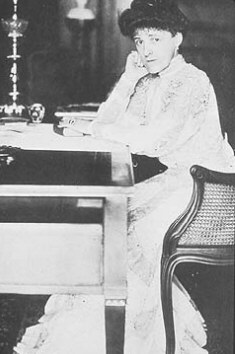
Since finding out about the existence of the Woman’s Literary Club half a decade ago, I’ve been wondering what members of the club thought of one of my great literary heroes (I’m not going to call her a heroine), Edith Wharton.
As a jaded grad student in the 1990s, Wharton’s novel The House of Mirth (her first, published in 1905) was the only book I read that actually brought me to tears.
It was also a novel that challenged American literary history as it was viewed at the time. Back then, when people talked about American literature of the 1890s, they talked about the “Age of Realism” and “the big three”– Mark Twain, Henry James, and William Dean Howells–who supposedly exemplified its principles.* Entire courses were titled “Twain, James, Howells,” focusing just on these three writers. During the 1990s, Wharton muscled her way into this stalwart triumvirate. Now she is usually paired off with James on American literature syllabi; both are represented as novelists of consciousness and as prose stylists who bridged the divide between realism and modernism.
What, I wondered, did the women of the Club—elite, educated, and cultured contemporaries of Wharton—think of her? Were they scandalized by the fact that she divorced her husband? Or did they admire her for abandoning her stifling society life in New York for a life among fellow intellects in Europe? Did they wish to emulate her as a stylist? Did they recognize her as one? Did they share her ironic ambivalence about what Thorstein Veblen described in 1890 as the “leisure class”? Did they share her desire to validate female independence, female intellect? So many questions.
So imagine my delight when, in the midst of transcribing the 1905-1906 minutes (and slogging through the Recording Secretary Mrs. Philip Uhler’s curlicued handwriting), I encountered a review of The House of Mirth, offered as part of the program from the Committee on Current Criticism (Mrs. Percy M. Reese, Chairman) on Feb. 13, 1906. It was reviewed by Club member Miss L. M. Kirk. Mrs. Uhler wrote,
Miss Kirk spoke of the power and strength of the book and of the interest of its conversations. We were told of a young girl, who chiefly for want of money, drops out of the pale of society, loses her courage, and even, innocently, her reputation. There is much shown of weakness, of the want of moral training and self-control. After reading it, we were reminded that we can be glad that the “Smart Set” is a small set. But Mrs Wharton’s subjects do not run away from her, as Mrs [Humphrey] Ward’s sometimes do. “The House of Mirth” is called the book of the year, and has a great sale. Miss Kirk quoted a review of it from “Life,” which considered its heroine as not well-balanced, and not a cause for tears. Miss Kirk treated “The House of Mirth” as literature, rather than as pleasing or satisfactory.
Yep– that’s it. A rather cursory review of the so-called “book of the year.” But there are a couple of interesting things to be said. One is the obvious distance Miss Kirk places between the “Smart Set” (the cosmopolitan elite centered in New York City) and the women of the Club. Based on the tone, Kirk rather dismisses this group, known in the press as “The Four Hundred” (sort of like the Fortune 500, but primarily including the social elite rather than the elite of the business world).
It’s also significant, I think, that Kirk focuses on Lily Bart’s “weakness,” her “want of moral training and self-control.” Clearly, Miss Kirk did not read Lily’s demise as the result of societal forces, as the novel is predominantly read now. Kirk faults Lily for her demise; she finds nothing wrong with society itself. This complacency is in keeping with what we’ve seen with the Club throughout its early years.
But most of all, I’m intrigued by Miss Kirk’s judgment of the novel “as literature, rather than pleasing or satisfactory.” These distinctions– between literature, pleasure, and satisfaction– are ones that continue to differentiate those who consider themselves scholars, and those we might call “lay readers,” people who read for fun. Clearly, this Club saw themselves as litterateurs, not dabblers or pleasure readers.
And—based on her comments—it looks like The House of Mirth may have made Miss Kirk cry, too.
(As a side note, which may become the subject of a future post, the 38th annual convention of the National American Woman Suffrage Association was occurring just a few blocks away at exactly the same hour that the Club was meeting, but they made no mention of it in the minutes.)
* Note. In retrospect, it seems to me that the only reason why Twain was classified as a realist at all is because he was held up as one by his good friend Howells. Howells, too, was never able to fully adhere to realist principles, even though he played a large part in defining them.

